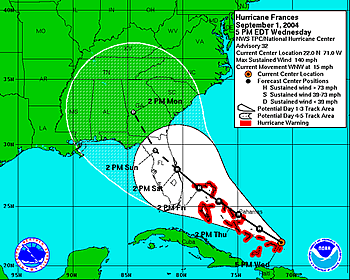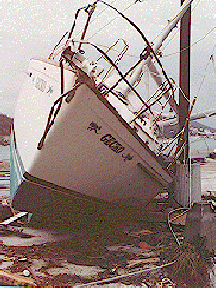Aftermath of Hurricane Marilyn, another Category 3 hurricane.
Image courtesy of FEMA
Hurricane Bonnie Update
News story originally written on August 25, 1998
From the National Weather Service, Miami, Florida, 11 a.m. EDT:
A hurricane warning remains in effect from Murrels Inlet, South Carolina to the North Carolina/Virgina border...Including Pamlico and Albemarle Sounds. A hurricane watch remains in effect from Savannah, Georgia to Murrells Inlet, South Carolina and from the North Carolina/Virginia border to Cape Henlopen, Delaware...Including the Chesapeak Bay Southward from Windmill Point.Preparations to protect life and property should be rushed to completion in the hurricane warning area. Interests in the watch and warning areas should follow recommendations from their local emergency management officials. The forecast track brings the center near the outer banks of North Carolina late Wednesday morning. Tropical storm force winds are likely to arrive at the coast of South Carolina and North Carolina near midnight and hurricane force winds near dawn Wednesday.
This hurricane has winds of 115mph. If this hurricane does reach the U.S. East coast, flooding and high winds could cause a lot of property damage. This hurricane has been very hard to forecast.
Here's the tropical update index supported by the Weather Channel.
You might also be interested in:

As a strong hurricane heads towards the coast, people prepare - boarding up houses, packing the car, and evacuating. These storms can spell disaster for people in hurricane prone areas, so they are taken
...more
How many hurricanes will form this year? How strong will they be? While no one can say for sure, teams of scientists make predictions each year about the strength of the upcoming hurricane season. To make
...more
It was another exciting and frustrating year for the space science program. It seemed that every step forward led to one backwards. Either way, NASA led the way to a great century of discovery. Unfortunately,
...more
The Space Shuttle Discovery lifted off from Kennedy Space Center on October 29th at 2:19 p.m. EST. The weather was great as Discovery took 8 1/2 minutes to reach orbit. This was the United States' 123rd
...more
A moon was discovered orbiting the asteroid, Eugenia. This is only the second time in history that a satellite has been seen circling an asteroid. A special mirror allowed scientists to find the moon
...more
Will Russia ever put the service module for the International Space Station in space? NASA officials want an answer from the Russian government. The necessary service module is currently waiting to be
...more
A coronal mass ejection (CME) happened on the Sun early last month. The material that was thrown out from this explosion passed the ACE spacecraft. The SWICS instrument on ACE has produced a new and very
...more















